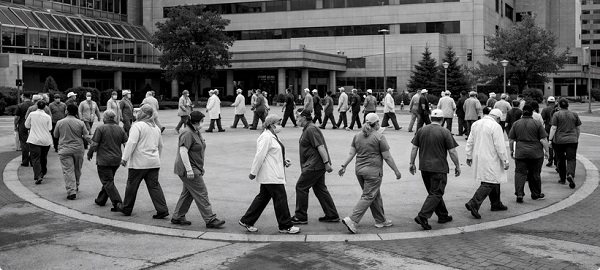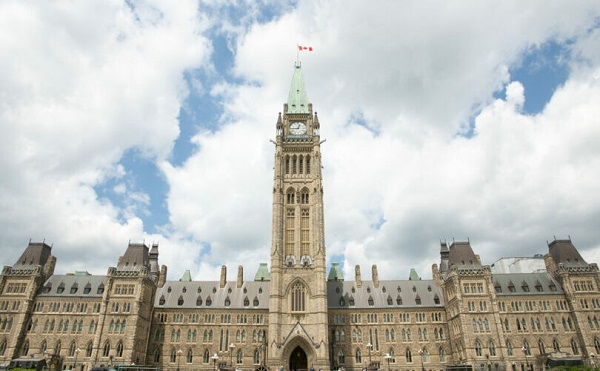Uncategorized
Here’s why young Canadians are pessimistic about the federal government

From the Fraser Institute
By Jake Fuss and Grady Munro
A new poll shows that the share of Canadians feeling pessimistic about the federal government has reached a new high. This should come as no surprise. Years of poor policy has left Canadians with a stagnant economy and declining living standards. And despite the Trudeau government’s recent focus on younger generations, young people appear the most pessimistic of all.
According to the poll conducted by Nanos, 39.8 per cent of Canadians feel “pessimism” towards the federal government—representing a seven-year high. On the flip side, 7.6 per cent feel “satisfaction,” a seven-year low.
More broadly, 68.7 per cent of respondents reported negative feelings (“anger” or “pessimism”) towards the federal government while just 16.3 per cent reported positive feelings (“optimism” or “satisfaction”). The remaining 15.0 per cent either weren’t sure or were simply disinterested.
Again, it’s not surprising that the majority of Canadians report negative feelings about Ottawa, in light of the Trudeau government’s fiscal and economic mismanagement.
For example, due to record-high spending, the Trudeau government will run its tenth-consecutive budget deficit in 2024/25 at a projected $39.8 billion. These deficits have contributed to a remarkable rise in federal government debt since Prime Minister Trudeau first took office. From 2014/15 (the Harper government’s last full year) to 2024/25, federal gross debt is expected to have approximately doubled to $2.1 trillion. And the Trudeau government has no plans to change course. Deficits are expected to continue until at least 2028/29, and projections suggest gross debt will increase an additional $400.1 billion over the same period.
What have Canadians gained from all this spending and debt?
Through the implementation of sweeping programs such as $10-a-day daycare and national dental care, the Trudeau government has expanded its role in the lives of Canadians. But because the government has chosen to use taxpayer dollars to provide services that were already offered privately, many Canadians have less choice of how to best to use their hard-earned money due to the imposition of higher taxes. Indeed, 86 per cent of middle-income families now pay more in taxes than they did in 2015, adding to the cost of living.
At the same time, Ottawa and some provinces have spent tens of billions on corporate welfare with the promise that it will promote economic growth. But over the last decade the economy has posted its worst performance since the 1930s, and Canadian living standards have been in a historic decline since mid-2019.
Finally, the burden of government debt and poor economic prospects may be why younger generations are feeling the most pessimistic. Indeed, among survey respondents aged 18 to 34, 41.3 per cent were “pessimistic” about the federal government while just 5.3 per cent were “satisfied” (the largest and smallest shares, respectively, relative to all other age groups). Despite the Trudeau government’s rhetoric about “generational fairness,” younger generations face a disproportionately higher tax burden in the future due to debt accumulated today. Meanwhile, according to long-term projections, Canadian living standards will fall further behind comparable countries (including the United States, Australia and the United Kingdom) over the coming decades.
Canadians are worse off today than they were 10 years ago, and should expect higher taxes and relatively little improvement in their living standards in coming years due to poor government policy. Is it any wonder they’re feeling pessimistic?
Authors:
Uncategorized
Mortgaging Canada’s energy future — the hidden costs of the Carney-Smith pipeline deal


Much of the commentary on the Carney-Smith pipeline Memorandum of Understanding (MOU) has focused on the question of whether or not the proposed pipeline will ever get built.
That’s an important topic, and one that deserves to be examined — whether, as John Robson, of the indispensable Climate Discussion Nexus, predicted, “opposition from the government of British Columbia and aboriginal groups, and the skittishness of the oil industry about investing in a major project in Canada, will kill [the pipeline] dead.”
But I’m going to ask a different question: Would it even be worth building this pipeline on the terms Ottawa is forcing on Alberta? If you squint, the MOU might look like a victory on paper. Ottawa suspends the oil and gas emissions cap, proposes an exemption from the West Coast tanker ban, and lays the groundwork for the construction of one (though only one) million barrels per day pipeline to tidewater.
But in return, Alberta must agree to jack its industrial carbon tax up from $95 to $130 per tonne at a minimum, while committing to tens of billions in carbon capture, utilization, and storage (CCUS) spending, including the $16.5 billion Pathways Alliance megaproject.
Here’s the part none of the project’s boosters seem to want to mention: those concessions will make the production of Canadian hydrocarbon energy significantly more expensive.
As economist Jack Mintz has explained, the industrial carbon tax hike alone adds more than $5 USD per barrel of Canadian crude to marginal production costs — the costs that matter when companies decide whether to invest in new production. Layer on the CCUS requirements and you get another $1.20–$3 per barrel for mining projects and $3.60–$4.80 for steam-assisted operations.
While roughly 62% of the capital cost of carbon capture is to be covered by taxpayers — another problem with the agreement, I might add — the remainder is covered by the industry, and thus, eventually, consumers.
Total damage: somewhere between $6.40 and $10 US per barrel. Perhaps more.
“Ultimately,” the Fraser Institute explains, “this will widen the competitiveness gap between Alberta and many other jurisdictions, such as the United States,” that don’t hamstring their energy producers in this way. Producers in Texas and Oklahoma, not to mention Saudi Arabia, Venezuela, or Russia, aren’t paying a dime in equivalent carbon taxes or mandatory CCUS bills. They’re not so masochistic.
American refiners won’t pay a “low-carbon premium” for Canadian crude. They’ll just buy cheaper oil or ramp up their own production.
In short, a shiny new pipe is worthless if the extra cost makes barrels of our oil so expensive that no one will want them.
And that doesn’t even touch on the problem for the domestic market, where the higher production cost will be passed onto Canadian consumers in the form of higher gas and diesel prices, home heating costs, and an elevated cost of everyday goods, like groceries.
Either way, Canadians lose.
So, concludes Mintz, “The big problem for a new oil pipeline isn’t getting BC or First Nation acceptance. Rather, it’s smothering the industry’s competitiveness by layering on carbon pricing and decarbonization costs that most competing countries don’t charge.” Meanwhile, lurking underneath this whole discussion is the MOU’s ultimate Achilles’ heel: net-zero.
The MOU proudly declares that “Canada and Alberta remain committed to achieving Net-Zero greenhouse gas emissions by 2050.” As Vaclav Smil documented in a recent study of Net-Zero, global fossil-fuel use has risen 55% since the 1997 Kyoto agreement, despite trillions spent on subsidies and regulations. Fossil fuels still supply 82% of the world’s energy.
With these numbers in mind, the idea that Canada can unilaterally decarbonize its largest export industry in 25 years is delusional.
This deal doesn’t secure Canada’s energy future. It mortgages it. We are trading market access for self-inflicted costs that will shrink production, scare off capital, and cut into the profitability of any potential pipeline. Affordable energy, good jobs, and national prosperity shouldn’t require surrendering to net-zero fantasy.If Ottawa were serious about making Canada an energy superpower, it would scrap the anti-resource laws outright, kill the carbon taxes, and let our world-class oil and gas compete on merit. Instead, we’ve been handed a backroom MOU which, for the cost of one pipeline — if that! — guarantees higher costs today and smothers the industry that is the backbone of the Canadian economy.
This MOU isn’t salvation. It’s a prescription for Canadian decline.
Uncategorized
Cost of bureaucracy balloons 80 per cent in 10 years: Public Accounts

The cost of the bureaucracy increased by $6 billion last year, according to newly released numbers in Public Accounts disclosures. The Canadian Taxpayers Federation is calling on Prime Minister Mark Carney to immediately shrink the bureaucracy.
“The Public Accounts show the cost of the federal bureaucracy is out of control,” said Franco Terrazzano, CTF Federal Director. “Tinkering around the edges won’t cut it, Carney needs to take urgent action to shrink the bloated federal bureaucracy.”
The federal bureaucracy cost taxpayers $71.4 billion in 2024-25, according to the Public Accounts. The cost of the federal bureaucracy increased by $6 billion, or more than nine per cent, over the last year.
The federal bureaucracy cost taxpayers $39.6 billion in 2015-16, according to the Public Accounts. That means the cost of the federal bureaucracy increased 80 per cent over the last 10 years. The government added 99,000 extra bureaucrats between 2015-16 and 2024-25.
Half of Canadians say federal services have gotten worse since 2016, despite the massive increase in the federal bureaucracy, according to a Leger poll.
Not only has the size of the bureaucracy increased, the cost of consultants, contractors and outsourcing has increased as well. The government spent $23.1 billion on “professional and special services” last year, according to the Public Accounts. That’s an 11 per cent increase over the previous year. The government’s spending on professional and special services more than doubled since 2015-16.
“Taxpayers should not be paying way more for in-house government bureaucrats and way more for outside help,” Terrazzano said. “Mere promises to find minor savings in the federal bureaucracy won’t fix Canada’s finances.
“Taxpayers need Carney to take urgent action and significantly cut the number of bureaucrats now.”
Table: Cost of bureaucracy and professional and special services, Public Accounts
| Year | Bureaucracy | Professional and special services |
|
$71,369,677,000 |
$23,145,218,000 |
|
|
$65,326,643,000 |
$20,771,477,000 |
|
|
$56,467,851,000 |
$18,591,373,000 |
|
|
$60,676,243,000 |
$17,511,078,000 |
|
|
$52,984,272,000 |
$14,720,455,000 |
|
|
$46,349,166,000 |
$13,334,341,000 |
|
|
$46,131,628,000 |
$12,940,395,000 |
|
|
$45,262,821,000 |
$12,950,619,000 |
|
|
$38,909,594,000 |
$11,910,257,000 |
|
|
$39,616,656,000 |
$11,082,974,000 |
-

 Business11 hours ago
Business11 hours agoHow convenient: Minnesota day care reports break-in, records gone
-

 Business1 day ago
Business1 day agoThe Real Reason Canada’s Health Care System Is Failing
-

 International11 hours ago
International11 hours agoTrump confirms first American land strike against Venezuelan narco networks
-

 Opinion1 day ago
Opinion1 day agoGlobally, 2025 had one of the lowest annual death rates from extreme weather in history
-

 Business1 day ago
Business1 day agoFederal funds FROZEN after massive fraud uncovered: Trump cuts off Minnesota child care money
-

 Business10 hours ago
Business10 hours agoThe great policy challenge for governments in Canada in 2026
-

 Addictions1 day ago
Addictions1 day agoCoffee, Nicotine, and the Politics of Acceptable Addiction
-

 Business1 day ago
Business1 day agoDark clouds loom over Canada’s economy in 2026







